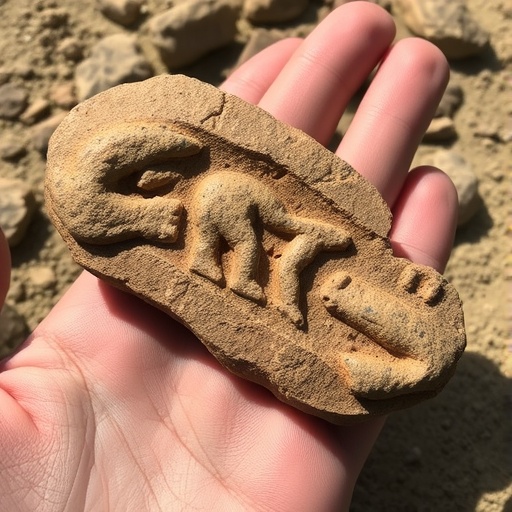In a groundbreaking revelation that reshapes our understanding of early human ingenuity and adaptation, an international consortium of researchers has unveiled compelling evidence of a sustained technological tradition dating back nearly three million years. Unearthed in Kenya’s Turkana Basin at the Namorotukunan site, this trove of Oldowan stone tools exemplifies the formidable skill and resilience of our early hominin ancestors amid staggering environmental upheavals during the Pliocene epoch. These pioneering artifacts, substantially older and more persistent than previously documented, paint a vivid portrait of prehistoric craftsmanship surviving against an ever-shifting African landscape.
The Namorotukunan assemblage displays remarkable consistency in the manufacturing of sharp-edged stone implements between approximately 2.75 and 2.44 million years ago. This continuity extends across an estimated 300,000-year interval, profoundly challenging the prevalent narrative that early tool use was sporadic or lacked refinement. Instead, this assemblage suggests a stable, inherited culture of tool-making, hinting at advanced cognitive abilities that allowed early hominins not only to craft but also to master and perpetuate a versatile technological repertoire within their ecological niches.
Central to understanding this archaeological marvel is the integration of cutting-edge dating techniques. Researchers employed volcanic ash stratigraphy, alongside magnetostratigraphy—tracking ancient magnetic reversals encoded in sedimentary layers—to precisely delineate the chronological framework. Complementary geochemical fingerprinting and palynological analyses of microscopic plant remains reconstructed the environmental backdrop, revealing fluctuations from lush wetland ecosystems to arid grasslands increasingly ravaged by wildfires. This multidisciplinary approach situates the stone tools within a dynamic milieu that demanded extraordinary behavioral flexibility from early toolmakers.
The stability of tool production during an epoch marked by environmental volatility underscores a profound example of cultural resilience. As shifting rains and spreading deserts reconfigured African landscapes, the persistent manufacture of Oldowan tools embodies an adaptive strategy that bolstered survival. These implements were not mere survival instruments but technological enablers facilitating dietary breadth expansion, particularly incorporating the butchery of meat. Cutmarks on fossilized bones from the site affirm that these tools were integral to meat processing, an activity likely pivotal for nutritional enhancement and evolutionary success.
Such enduring technological continuity suggests that early hominins possessed a sophisticated knowledge transmission system, potentially through social learning mechanisms more intricate than once appreciated. The fact that tool-making remained relatively unchanged over an extensive timespan implies a cumulative cultural tradition rather than isolated innovations. This challenges the assumption that early stone tools represent rudimentary, opportunistic flaking and opens avenues for reevaluating cognitive and social complexity among early Homo species during the emergence of the Oldowan technology.
The significance of these findings resonates beyond archaeology, intersecting paleoanthropology, geology, and evolutionary biology. The flint knapping precision evident at Namorotukunan bespeaks of methodological skill passed down through generations, with early hominins repeatedly honing sharp flakes and cores optimally designed for cutting, scraping, and butchery. In evolutionary terms, such technological proficiency likely conferred selective advantages, enabling more efficient exploitation of carcasses, nutritional diversification, and enhanced survival amid climatic adversities.
Furthermore, this discovery refines timelines relating to the origins of the Oldowan technology, advancing current estimates and demonstrating that by 2.75 million years ago, early hominins had already attained considerable technological sophistication. The implications extend to hominin taxonomy debates, suggesting that multiple hominin groups during this epoch may have converged on or inherited shared technological traditions. It invites reconsideration of evolutionary models that spotlight behavioral innovation as abrupt and episodic, favoring instead incremental cultural evolution.
The environmental reconstructions derived from sediments and fossil pollen reveal a Pliocene epoch punctuated by drastic swings in humidity, vegetation, and fire regimes. Such transient conditions intensified selection pressures, promoting adaptability and resilience. Amid this ecological turbulence, the sustained presence of stone tool technology at Namorotukunan offers a compelling narrative of human ancestors deploying cultural technology as a buffer, stabilizing lifestyles through effective resource procurement strategies.
Synergizing archaeological data with paleoenvironmental evidence affords an unprecedented lens into hominin lifeways during one of Earth’s most formative climatic intervals. The ability to navigate radical habitat transformations over hundreds of millennia provides a paradigm for investigating early human technological and behavioral evolution. The Namorotukunan findings fortify the hypothesis that technology constituted a fundamental evolutionary toolkit instrumental in hominin survival and dispersal across diverse environments.
Moreover, the multinational and multidisciplinary nature of this research amplifies its scientific impact. Collaborators from Kenya, Ethiopia, the United States, Brazil, Germany, and other nations combined expertise in archaeology, paleontology, geology, and chemistry, underscoring the importance of global partnerships in deciphering our deep past. The inclusion and support of local communities—the Daasanach and Ileret—highlight ethical collaboration models crucial to sustainable and respectful scientific endeavors.
The team enthusiastically credits logistical support from institutions such as the National Museums of Kenya and funding from prestigious organizations including the U.S. National Science Foundation and the Leakey Foundation. This highlights the vital role of sustained funding in enabling high-precision fieldwork and advanced laboratory analyses that collectively push the boundaries of human evolutionary knowledge.
As the oldest known continuous Oldowan technological tradition, the Namorotukunan assemblage redefines early hominin innovation narratives. The enduring craftsmanship and adaptability it embodies provide profound insight into the evolutionary roots of human culture, cognition, and survival strategies. These findings illuminate the origins of humanity’s intrinsic relationship with technology as a stabilizing response to environmental challenge—a legacy that resonates across millions of years and continues to shape us today.
Subject of Research: Early Oldowan stone tool technology and hominin adaptation during the Pliocene epoch in the Turkana Basin, Kenya.
Article Title: Early Oldowan technology thrived during Pliocene environmental change in the Turkana Basin, Kenya
News Publication Date: 4-Nov-2025
Web References: https://www.nature.com/articles/s41467-025-64244-x
Keywords: Anthropology, Oldowan technology, early hominins, Pliocene, Turkana Basin, stone tools, paleoenvironment, cultural continuity, paleoanthropology, human evolution




